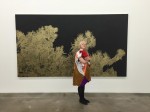The sights and sounds of Whitney Bedford’s studio disappear. With her first brush strokes, the UCLA alumna is transported into the world of her artwork, where she said paint and her inner emotions intertwine and manifest themselves as one on a blank canvas.
After she graduated in 2003, Bedford’s art has been featured in exhibitions in cities throughout the world, such as Paris, Berlin, Prague and Milan.
Bedford currently teaches an art class called “Drawing the Subject” at the University of California, San Diego, painting for six to eight hours at her studio four days a week, and raises her six-month-old daughter.
The Daily Bruin’s Victoria Vallecorse spoke with Bedford on her UCLA graduate school experience, her international artwork exhibitions and how she incorporates emotion into her paintings.
Daily Bruin: What makes your artwork unique to you?
Whitney Bedford: If I am having one of those moments in my life where I am going through a particular emotion, I’ll pick imagery that I think reflects that, so my artwork is kind of like my diary … I paint throughout a period of emotion in my life, so (the paintings) act like vehicles, or receptacles for that emotion.
DB: Your artwork includes many paintings of fireworks and landscapes, to name a few. How did emotion play a part in your decision to paint these scenes?
WB: The fireworks I did when I was in love, so the last set of fireworks I painted were when I met and married my husband. Those were actually collaborative where he would take pictures of fireworks, and I would paint them.
The landscapes are more about rooting myself here in LA. There are two different types of landscapes, one (of which is) called “Lala Land,” that features palm trees, which still fascinate me, having grown up on the east coast.
DB: When did you realize your passion for art?
WB: It was always something that I was drawn too. When I was applying to colleges in high school, my parents really did not want me to go to art school because they wanted me to have a more rounded education … But I applied to the Rhode Island School of Design to basically test my prowess, and see if I could get in, and I did. In 1999, I had gotten a Fulbright (grant) to go study architecture and painting in Berlin, so then I was in Berlin for two years. Then, I came to UCLA to pursue my MFA.
DB: What was it like studying art here at UCLA?
WB: The artists I had studied and admired were all there, like Charlie Ray, Chris Burden and Paul McCarthy, to name a few. It was such a wonderful experience to work with people who you have greatly admired and be able to start a conversation and become a peer.
It’s a totally different feeling from art programs in East Coast art schools where there is a sense of uber-competitiveness, whereas while UCLA and LA in general are competitive, it feels more like a community.
DB: What made you want to stay in Los Angeles after graduation?
WB: The art scene here is just so dynamic and interesting, it feels like there is always something new going on. Also, I think you go to graduate school to make connections that are going to start your career, and my career did start here and I just felt like I had to stay to usher it along … I was happy to stay, because I think LA is really receptive to all sorts of disciplines and ideas. I love that fantasy and reality are so intertwined here, and I think that’s a really potent thing for an artist to work with.
DB: What projects are you currently working on?
WB: I am working on a bunch of landscapes for a show that will open in Auckland, New Zealand next month. The landscapes are collages and ideas from Huntington gardens in Pasadena.
DB: Your art has appeared in exhibitions all over the globe. Have you traveled to each place where your artwork is featured?
WB: I usually go if it’s a solo show, and it’s a real honor to get to travel like that to be with the work and to get to see it in all these different places … I also like travel to look at different colors and different places. Sometimes I’ll travel with a friend who is a travel writer and we’ll go on story lines like that.
DB: How does it feel to have your artwork displayed throughout the world?
WB: My work is super personal, so to see it in another space in a different part of the world makes for a huge shift in the body of work because it has an audience that I don’t know of, and that’s really exciting.
Compiled by Victoria Vallecorse, A&E contributor.
